When a violent killer targets women or a lone gunman shoots children, some commentators suggest that the media should avoid focusing on the culprit, and instead concentrate on the victims. The idea behind this well-meaning suggestion is that we should not give attention to the killers for fear of encouraging new mass-murderers.
A different view is offered by Dr James Kent (Richard Kiley) in Edward Dmytryk’s film noir, The Sniper. In a heated meeting where one member suggests, “The important thing to think about is three dead women, not coddling the man who killed them,” Kent retorts: “Look, I’m thinking of the hundreds of women who will be dead if something isn’t done.”
Here is a different wrinkle on the age-old debate concerning serial killers and violence against women. If we focus on the murderer rather than his victims, then perhaps this might prevent further deaths in the future.
This is the central problem posed by Dmytrk’s movie. Edward Dmytryk made The Sniper as a return to American movies following a short period where he was blacklisted for Communist links. The beleaguered director was reinstated in American cinema after he named names to the House of Un-American activities.
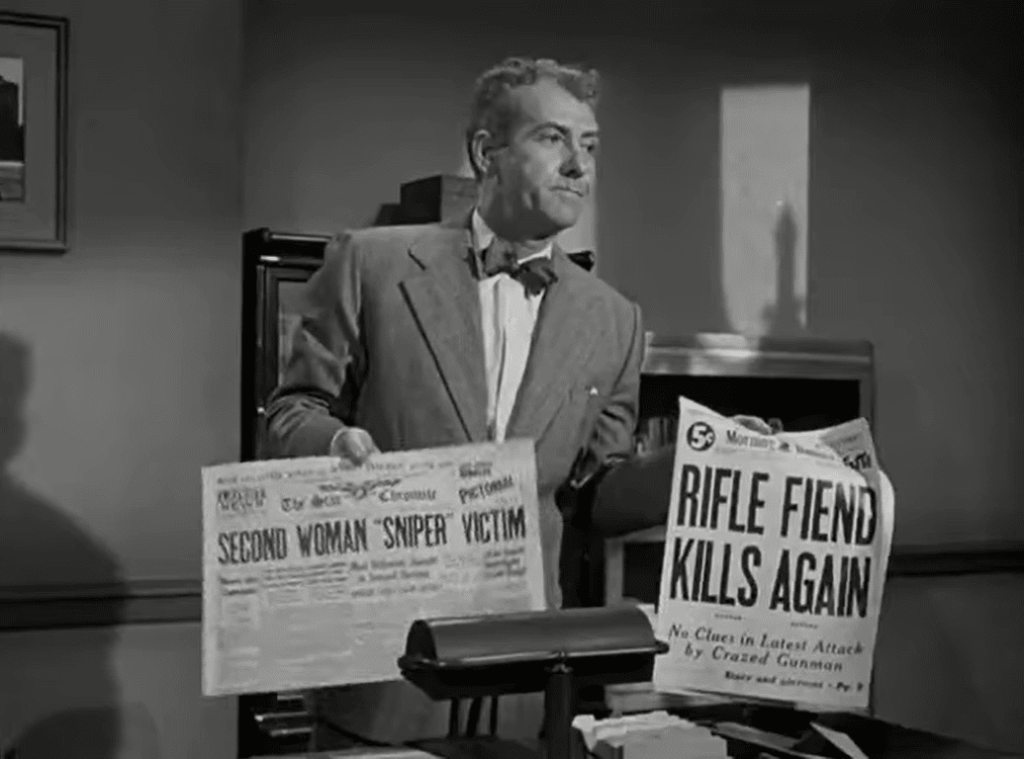
Nonetheless The Sniper seems a curious choice of film for a director who had recently been under scrutiny, especially since this film noir arguably belongs to the sub-category known as film gris, a name referring to film noirs that contained a subtle left-wing message.
It probably helped that one of the leading actors in the movie was Adolphe Menjou, a man of literally unimpeachable reputation in the era of McCarthyite witch hunts. Menjou was a staunch Republican and anti-Communist who had happily co-operated with the House of Un-American Activities in their hunt for Reds.
What induced Menjou to work with a director who had been on the other side of the political divide? “Because I’m a whore,” explained Menjou. Curiously the director and actor had a good professional relationship during the making of the movie.
Menjou, amusingly enough, plays a police lieutenant called Frank Kafka. He is not a sinister authority figure however, only a public official seeking to do his job. The name does perhaps suggest something of the oppressive world of The Sniper, even if Kafka’s character does not.
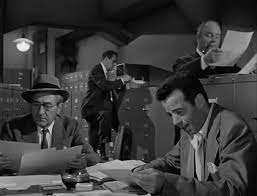
The film takes place in an unnamed city which is obviously San Francisco. The steep streets of the city seem to reflect the unbalanced and slanted worldview of its lead character, Eddie Miller (Arthur Franz). Here is a man who never sees things from a level or stable angle.
Eddie walks the narrow streets, which are often empty, an objective correlative for his own life. He has no friends or family members who support him. He has no idea how to speak to a woman he likes, and there are not many women that he likes. Even a friendly attempt by Eddie to pass a ball to some street children ends badly.
When he is not delivering laundry, Eddie lives in a claustrophobic apartment. No matter in which direction the camera moves around the room, we see the walls close by. Eddie’s room is seen in the opening credits. It seems to be an ordinary room with the usual mundane trappings until Eddie opens a drawer to reveal an enormous rifle that seems out of proportion for the needs of a man living in the middle of a large city.
How did Eddie obtain such a gun? Who knows? This is America, a place in which guns are easily obtained. Perhaps he is an ex-soldier, as some of the investigators speculate. Other guns appear in the movie. The police are armed. A would-be copycat is arrested while carrying an antiquated gun owned by his father. The local fair has a shooting gallery where the visitors can practise using a fake gun.
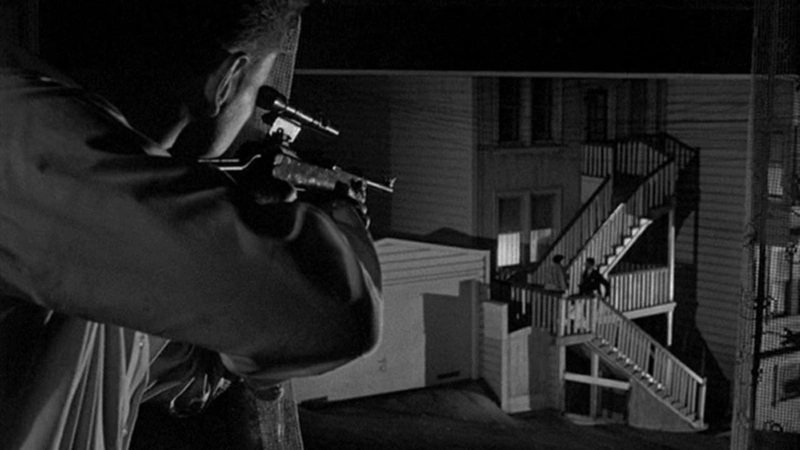
As for Eddie, the gun is not just there for self-defence. He takes the rifle out and points it at his neighbour while she is publicly kissing a man. Will Eddie kill a woman from his own apartment? He aims and squeezes the trigger, but the rifle is empty.
Nonetheless we know what kind of man Eddie is now. He is a mentally disturbed individual with a hatred of women. He is easily triggered by any woman who talks about men, who discusses finding a new boyfriend, or who engages in public displays of affection.
A pre-credit statistic informs us that the sex criminal has been responsible in the last year alone for offences victimising 31,175 women. That is just the reported numbers. The Sniper is not about one unusual case. It is about a problem across American society.
What has caused Eddie to hate women so much that he is prepared to murder them? There are hints that the problem relates to his relationship with his mother. When Eddie sees a mother slap a child, he instinctively puts his hand to his face, hinting at a history of childhood abuse. “My mother never taught me anything,” he later snarls, though sadly this is not true.
Later Dr Kent offers his psychological profile of the murder. He imagines a history of mistreatment from a woman: “Whoever it was, he’s killing her over and over again,” the doctor suggests. As Kent imagines, Eddie has already been in the ‘psycho ward’ of a prison for hitting a girl.

Wherever Eddie goes he sees women that he wishes to attack. When throwing balls at a fairground event to unseat a woman sitting on a swing above a tank of water, Eddie takes pleasure in ducking her into the water again and again, his face contorted with hatred. When she doesn’t get out of the pool, he hurtles the balls at her face, which is protected by the mesh. Eddie can scarcely keep his mind on the shooting gallery, because he wants to murder a young woman on a Ferris wheel.
Yet Eddie seems to be more pitiful than vile. Here is a young man who is horrified by his own actions. He knows that there is something wrong with him, but he cannot stop himself. Eddie tries several times to get the attention of the authorities, but he is thwarted by a system that lacks the time, resources, and sometimes the inclination to help him.
When Eddie is fighting the urge to take the rifle out of his drawer, he puts his hand on his stove so that he can go to his local hospital. A doctor is concerned about this deliberate act of self-harm, but it is a busy day at the hospital, and nobody takes the issue further, even when Eddie pleads that it is a matter of life or death.
Eddie tries to phone the prison doctor who supported him while he was inside, but the doctor is away for two weeks, and nobody else will help. Should Eddie have been released without psychiatric support just because his sentence had ended? Even after the killings begin, Eddie writes a poignant note to the police: “Stop me – Find me and stop me. I’m going to do it again”. This is no bravado – this is a cry for help.
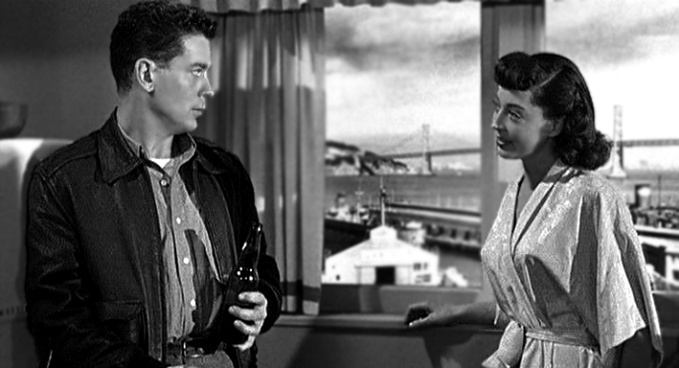
Inevitably Eddie moves from ideation to putting his urges into practice. The first victim is one of his customers, a cocktail pianist, Jean Darr. She is played by Marie Windsor, a frequent supporting actress in B-movies, and one who often comes to an unhappy ending. This time she has done nothing to deserve it.
It is obvious that Eddie is romantically attracted to Jean, but this sours when she hurries him out of her apartment because she has a jealous girlfriend. As she leaves her workplace, Eddie shoots her with his rifle. She falls against the glass of a notice advertising her piano playing, and the glass shatters. With it, the peace of San Francisco shatters too. A new threat has begun.
Other victims follow – a drunken woman is shot in her apartment. A philanthropic woman gives out her address on television, and is killed at home. A woman is murdered in the park. An unfortunate witness is shot while trying to warn the town. In each case, Eddie shoots them from the top of a building. He is literally looking down on his victims.
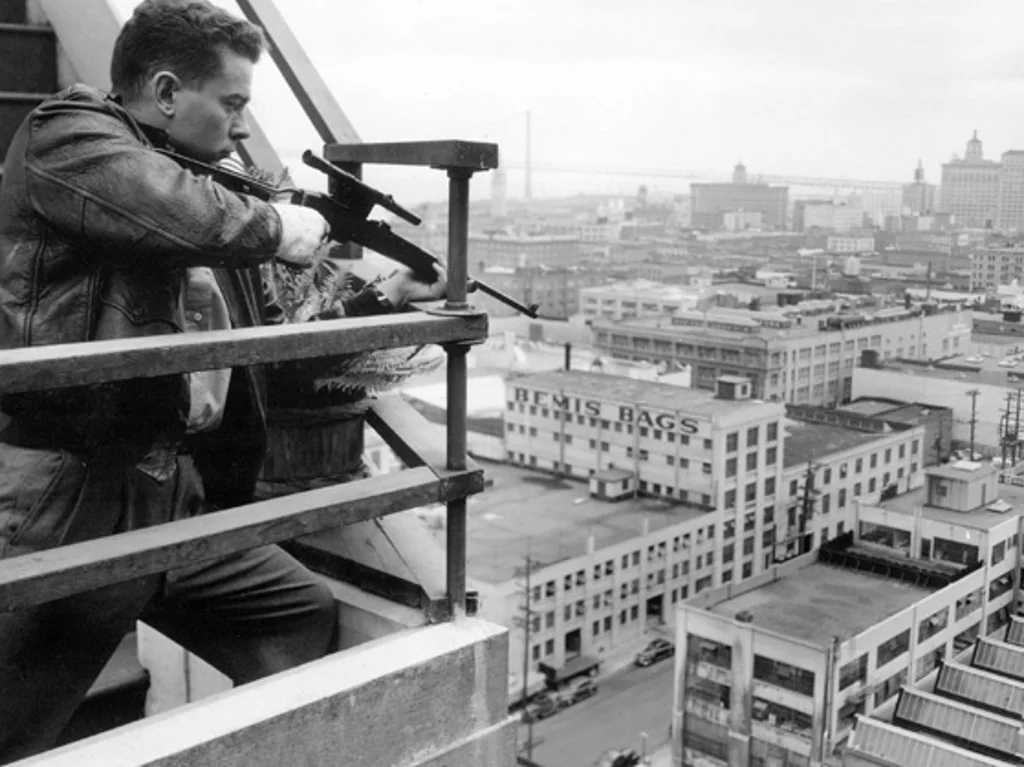
The Sniper is more than a serial killer film however. It is also a police procedural drama, filmed in the quasi-documentary style of many crime movies that aim for realism. The story follows the investigation into the crimes by Lieutenant Kafka and Sgt Joe Ferris (Gerald Mohr).
They move from investigating individuals connected to the first victim to investigating potential sex murderers when other women are killed in the same way. They accept the help of a doctor who understands sex offenders. In one amusing scene, they bring in a police line-up of convicted or suspected sex criminals, and a cynical police officer mocks them.
Kafka and Ferris are well-meaning and capable crime fighters, but they can do little more than capture yet another killer. The problem is not one of law enforcement, but of the absence of laws that might have prevented Eddie from killing in the first place. This is an avoidable tragedy that Eddie himself wanted to escape, but by the time it has reached the hands of Kafka and Ferris it is already too late.

The police investigation is hindered by short-sighted public officials who cut the police budget, and who see the matter as being more about capturing, and either committing or executing the offender. Dr Kent, pleads with the authorities, but his words fall on deaf ears:
Yes, loose because of us. And a killer because of us. And the horrible thing about it is we may be sitting here…three months from now on another case just like it. Gentlemen, the city is frightened, and when cities get frightened, they rear up on their hind legs and strike out at something, anything. This time we have a chance not to strike out blindly, but to act with reason…. Let every socially dangerous sex offender, as soon as he is caught for his first offense, be committed to a mental institution, and there he can be cured or put away indefinitely.
His words fall on deaf ears. “Who cares what you think?” one man replies. Certainly not the general public who ghoulishly gather around the crime scenes, or the home of Eddie when the police finally catch up on him. They want to see a kill.
They will be disappointed. There is no dramatic shoot-out at the finish to encourage the viewer to want to see Eddie gunned down – just a final low-key encounter with a tearful killer.
The film offers just one glimmer of hope. When a young would-be imitator of Eddie is arrested and makes it clear that he would like to follow in Eddie’s footsteps one day, Kafka has the young man sent to a psychiatric ward. Perhaps that might mean one potential serial killer has been stopped.
While The Sniper might be criticised for expressing its message in a heavy-handed manner, the film represents a serious attempt to look at the problem of the sex killer, albeit one who does not rape or molest his victims. In some respects The Sniper anticipates films such as Joker, which also portray the killer as being as much a victim as a culprit, and a reflection of the failure of society to solve deeper problems.
Dmytryk does a good job of directing a film that is always interesting, and which is often tense and suspenseful. The Sniper is good entertainment, as well as a movie with a poignant and important message.

One thought on “The Sniper (1952)”